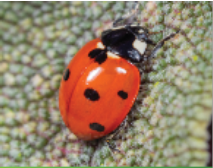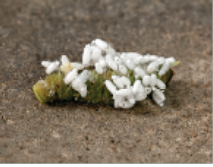
Pest Management Using Integrated Strategies
Homeowners and producers enduring occasional pest outbreaks often over-rely on chemical management strategies or react after pests can be managed effectively. Pest management using multiple methods, otherwise known as Integrated Pest Management (IPM), is a strategy combining a wide range of tactics, including biological, chemical and cultural practices to provide long term, environmentally sustainable, and economically feasible control. By applying a range of tactics, individuals can minimize pesticide resistance, reduce impacts towards beneficial species, and eliminate secondary pest outbreaks while maximizing long term profits. This guide provides details regarding the concept of Integrated Pest Management, including various pest management approaches, how to identify a pest, monitoring techniques, developing a pest management goal, implementing the program, and recording and evaluating results.
Last Updated: 07/21by Cecil Tharp, Pesticide Education Specialist

History
Post 1950s America was heavily dependent on synthetic organochlorine pesticides such as DDT and dieldrin for invertebrate pest control. These low-cost pesticides were highly effective at managing pests, however the pre-20th century knowledge of non-chemical approaches was temporarily lost. The overuse of synthetic pesticides through the mid-20th century resulted in pest resistance, loss of beneficial organisms and persistent pesticides that eventually impacted non-target sites.
Pest Resistance. Pesticides became increasingly ineffective at managing many pests due to overuse. Pest resistance is defined as the ability of a pest to tolerate a pesticide that once controlled it. Resistance takes place due to repeated pesticide applications using one chemical mode of action, thus selecting for survivors with an inherent genetic advantage to the chemical applied. Variables that increase the chance of pesticide resistance include frequent applications, using only pesticide(s) with one mode of action, low product rates, persistent chemistries, and high pest reproductive rate. Mixing modes of action, using high product rates and using non-chemical approaches are all useful approaches to slow pest resistance.
Resistance: The ability of a pest to tolerate a pesticide that once controlled it.
Loss of Beneficial Organisms. The overuse of broad- spectrum insecticides negatively impacts many beneficial arthropod species. Beneficial species are often referred to as “natural enemies.” There are various parasites, predators, and pathogens that reduce pest populations. The use of broad-spectrum insecticides may decrease the survival of many natural enemies (i.e. predatory insects or beneficial pathogens), thus causing a secondary pest outbreak, or a resurgence of the original pest. Either ecological imbalance leads to further pesticide applications, and an over-reliance on pesticides for managing pest populations. Applicators finding beneficial arthropod species should be wary when using broad-spectrum insecticides (Table 1).
Persistent Pesticides Impacting Non-Target Sites. Even though pesticide applications may not impact non-target sites initially; persistent chemistries may eventually move to non- target areas. Non-target injury may include losses to future susceptible crops (i.e. carryover), water contamination through movement via leaching or runoff, or bio-accumulation, or bio-magnification in the environment (an accumulation of contaminants higher than surroundings). The heavy use of DDT in the 1940s, 50s, and 60s led to shell thinning of bald eagle eggs due to bio-magnification in fat tissues. The DDT concentrations that were absorbed by the eagles were up to 10 million times what was originally applied by pesticide applicators (Figure 1).
Table 1. Photos of beneficial species, including select predators and parasitoids.
Beneficial Organism |
Benefit |
Photograph |
Lady Bird Beetle |
Specialized predator on aphids, alfalfa weevil larvae, and other pest species. |
 |
Green Lacewing |
Specialized predator on aphids. |
 |
Spider |
Generalist predator on smaller and larger insects. |
 |
Chickens and Guinea Hens |
Generalist predator on larger insects. |
 |
Parasitoid Wasp |
Parasitoids can target a variety of pests (i.e. parasitoid larvae on Tomato Horn Worm). |
 |
ALL IMAGES FROM ADOBE STOCK
Today, persistent chemistries that bio-accumulate in fat tissues are rarely registered by the EPA, and the use of these chemicals has greatly diminished with the advent of integrated pest management. Applicators should be wary of other persistent pesticide chemistries which may move off-site by erosion, leaching or runoff, or persist in that area to harm future non-targets.

Figure 1. Bio-magnification of DDT in the food chain. NASDARF, NATIONAL PESTICIDE APPLICATOR CORE MANUAL, 2ND EDITION
Integrated Pest Management
The problems with relying primarily on pesticides led to a renewed approach to managing pests. Integrated Pest Management combines a wide range of tactics including biological, chemical cultural, genetic, mechanical and regulatory practices to provide long term, environmentally sustainable, economically feasible control.
Biological control is the use of natural enemies such as predators, parasitoids, and pathogens to manage pests. This usually is effective at only suppressing pest populations and tends to take a longer period of time to produce results. It is recommended that less toxic pesticide approaches are used when combined with biological control agents (i.e. Aphid biological control agents include lady bird beetles and lacewings; Table 1).
Chemical control is managing pests using natural or synthetically-derived chemicals to manage pest populations, often referred to as pesticides. Pesticides are used to attract, repel, kill, or interrupt pest growth. These chemicals are grouped according to the type of pest they manage (i.e. herbicides manage weeds, insecticides manage insects, rodenticides manage rodents, etc.).
Cultural control alters the environment of the pest to eventually reduce pest establishment and survival. Some examples include mowing, irrigating, mulching, cultivating, crop rotation, harvest timing and planting timing.
Genetic control manages pests by growing genetically- modified crops or animals that are able to tolerate or negatively impact pest populations. Two genetic techniques that are used are selective breeding and the laboratory transfer of resistant genes from one organism to a new species (Trans- Genic). Some examples include Roundup Ready alfalfa or Bacillus thuringiensis corn.
Mechanical control manages pests directly by mechanically-manipulating the environment, or indirectly by providing a barrier of some kind. Some examples of mechanical control include vertebrate pest traps, snares, and fly swatters.
Regulatory control invoking quarantines and eradication are usually directed by government agencies. This is usually used when pests endanger public health or when exotic pests pose a risk towards agricultural crops, animals, forests, recreation, or ornamental plants.
Some benefits of IPM include:
- Maintaining a healthy ecosystem through use of non- chemical methods when possible (i.e. minimize injury to beneficial organisms, minimize risk of contamination of water sources, etc.).
- Using pesticides only when they are proven effective (i.e. timing of application, resistance, etc.).
- Save money (i.e. only use pesticides when necessary, only use when pests reach threshold levels, reducing costs of health concerns from overuse of pesticides).
- Maintains a good public image (i.e. least toxic methods often preferred by the public).
The public, at times, interprets IPM as a non-chemical approach. This is not true. IPM reduces chemical usage when compared to a reliance only on pesticides, however pesticides are still part of the overall strategy.
Implementing an IPM Program
When implementing an IPM program, applicators are urged to use resources that provide the proper identification, monitoring, and development of a pest management goal. Some of these resources include the online multi-state “High Plains IPM Guide” (https://wiki.bugwood.org/HPIPM:Main_ Page), MSU Extension agents and specialists, weed districts and other local professionals.
1. Identify pest. To use IPM, an applicator must identify the pest and understand its biology. After the pest has been categorized as a weed, disease, invertebrate, or vertebrate, it’s important to determine the species. If the pest remains difficult to identify, contact the Schutter Diagnostic Laboratory at http://diagnostics.montana.edu/, or contact an MSU Extension agent. Once a pest is identified to species, an applicator can easily determine whether it is a key, secondary or occasional pest.
Key pests cause major damage on a regular basis. Secondary pests become a problem when key pests are absent or managed. For example, managing alfalfa weevil using broad-spectrum insecticides often kills lady bird beetles, thus causing a secondary outbreak of aphids later in the season. Occasional pests are a problem sporadically due to their life cycle, environmental influences, or as a result of human activity. Grasshoppers usually have an outbreak every 7–10 years due to the impact of cycling weather conditions.
2. Monitor the pest. Once a pest is identified, an IPM program should include routine monitoring of the pest. This entails either monitoring the pest, or indirectly measuring the damage caused by the pest. Monitoring could range from measuring the number of pests per plant to estimating the number of pests using sweep-nets, sticky traps, pit-fall traps, etc. There are many resources and guides available that provide directions on routine monitoring practices. Monitoring is key to determining when control measures are necessary, especially for common insect pests that have established action models that provide actionable information when pest numbers meet specific thresholds in the field.
The presence of a pest does not always necessitate the use of costly control measures. Pest populations must be large enough to justify the use of pesticides, fuel, etc., by also taking into account the value of protecting the commodity damaged. The economic threshold (ET) is the pest density at which control measures are needed to keep the pest from reaching the economic injury level (EIL). The EIL is the pest density at which the cost of damage from the pest equals the cost of managing the pest. Setting the ET below the EIL ensures pest managers don’t lose money (Figure 2). Some pests have an ET set at zero due to human health risk, quarantines in place, or being labeled as a priority pest species (i.e. noxious weeds, mosquitoes of West Nile, cockroaches).

Figure 2. An example of how an economic threshold keeps pest populations from reaching the economic injury level.
NATIONAL APPLICATOR CERTIFICATION CORE MANUAL, NASDARF
3. Develop a pest management goal. Individuals using IPM must decide if the pest management goal is eradication, prevention or suppression. With this information individuals can determine whether pesticides, non-chemical, or a mix of approaches are ideal.
Eradication may be effective in buildings or other interior spaces, however over larger areas this technique is largely ineffective for pests. For example, it may be necessary to eradicate rodents in a food service company, or if the pest is an exotic pest with quarantine restrictions. Eradication approaches in the mid-20th century using DDT or dieldrin not only failed to eradicate pests but caused increased pest resistance due to the excessive use of pesticides.
Prevention is a proactive approach to managing pests including planting weed-free seed, growing tolerant varieties of plants, or using cultural control techniques. Other methods include using pre-plant herbicides or seed treatments.
Suppression is a reactive pest control tactic designed to reduce already existing pest populations below the EIL. Techniques to suppress populations include pesticides, cultivation, mowing weeds, and releasing biological control agents.
4. Implementing the IPM program. An IPM program can be implemented once thresholds are identified and monitoring and management techniques are selected.
5. Record and evaluate the results. It is critical to evaluate the results of the program to gauge the need to alter the program using different techniques.
Conclusion
IPM will aid individuals in managing pest outbreaks more effectively using a variety of tools, while making cost-effective decisions. To implement a successful IPM program, individuals must identify the pest, and classify it as a key, occasional or secondary pest. With this information individuals can determine the most appropriate monitoring technique and the threshold for each pest identified. When thresholds are exceeded individuals must decide what management approach to implement. Each management technique within the IPM plan must be evaluated periodically to determine effectiveness. If poor efficacy or unintended human/environmental risk is observed individuals should evaluate timing, sensitive sites, weather conditions, and whether other IPM choices may better fit their program.
For Questions
If you have questions regarding this article contact the MSU Pesticide Education Program (406-994-5067, pesticides@montana.edu, pesticides.montana.edu). For questions regarding IPM resources in Montana contact the MSU IPM program (406-994-1750, http://ipm.montana.edu/).

